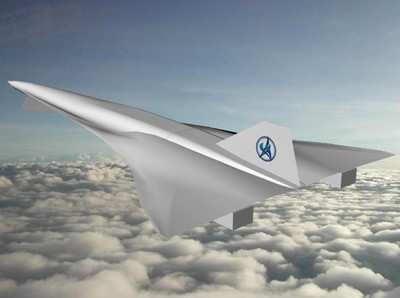Two U.S. Teams And One From Japan Take Top Honors
 Since the Concord went
out of service in 2003, a return to commercial air travel at
speeds above Mach 1 has been a goal of designers and engineers
around the world. Now, eight college students have summer
jobs at NASA this year, thanks to their participation in a contest
to design a supersonic airliner.
Since the Concord went
out of service in 2003, a return to commercial air travel at
speeds above Mach 1 has been a goal of designers and engineers
around the world. Now, eight college students have summer
jobs at NASA this year, thanks to their participation in a contest
to design a supersonic airliner.
College students from the U.S., Japan and India researched
technology and created concepts for a supersonic passenger jet as
part of a competition sponsored by the Fundamental Aeronautics
Program in NASA's Aeronautics Research Mission Directorate.
The participants were challenged to design a small supersonic
airliner and submit a research paper limited to 25 pages. Designs
had to be efficient, environmentally friendly, low sonic boom
commercial aircraft that could be ready for initial service by
2020.
A team of undergraduates from the
University of Virginia in Charlottesville, Va., and a team of
graduate students from the Georgia Institute of Technology in
Atlanta tied for first place in the U.S. division. A University of
Tokyo undergraduate team won top honors in the non-U.S.
category.

Virginia Concept Courtesy
NASA
Six participants receiving internships were selected from the
award-winning teams. All eight recipients are engineering or
management students and were selected based on their resumes, grade
point averages and application letters. The students are serving
their internships at three NASA centers: Langley Research Center in
Hampton, Va.; Ames Research Center at Moffett Field, CA; and the
Glenn Research Center in Cleveland.
"We use these competitions to generate excitement for
aeronautics and the engineering behind aviation," said Peter Coen,
principal investigator of the Supersonics Project at Langley. "I
was pleased by the number and diversity of the entries we received.
And I was impressed by the quality and innovative thinking
demonstrated in the designs."

Georgia Concept Courtesy
NASA
This year's competition also fostered an unusual collaboration
across the country and two continents. Four students, one from
Florida, another from California and two from Australia, worked
together over the Internet to design an airliner. Three of the four
had met last year as a result of the contest. The team tied for
second place with an undergraduate team from Purdue University in
West Lafayette, IN.
An undergraduate team from Sardar Vallabhbhai Patel Institute of
Technology in Gujarat, India won second place in the international
division.

Japanese Concept Courtesy
NASA
A group of NASA engineers reviewed the entries. The judges based
their scores on how well students addressed all aspects of the
problem they chose to discuss. The judges used the following
criteria: innovation and creativity; discussion of feasibility; a
brief review of pertinent literature; and a baseline comparison
with the relevant current technology, system or design.
Winning participants received prizes, including up to $5,000,
and will be invited to a student forum sponsored by NASA. Students
were also eligible for 24 summer internships. Only U.S. citizens
may be awarded cash prizes or NASA-funded internships. Non-U.S.
teams will receive an engraved trophy. All participants also will
receive a NASA certificate.
 Bolen Gives Congress a Rare Thumbs-Up
Bolen Gives Congress a Rare Thumbs-Up The SportPlane Resource Guide RETURNS!!!!
The SportPlane Resource Guide RETURNS!!!! Buying Sprees Continue: Textron eAviation Takes On Amazilia Aerospace
Buying Sprees Continue: Textron eAviation Takes On Amazilia Aerospace Hawker 4000 Bizjets Gain Nav System, Data Link STC
Hawker 4000 Bizjets Gain Nav System, Data Link STC Echodyne Gets BVLOS Waiver for AiRanger Aircraft
Echodyne Gets BVLOS Waiver for AiRanger Aircraft






